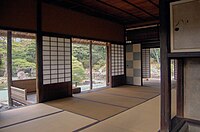Portal:Architecture/Selected article/2007-25
The Katsura Imperial Villa (桂離宮, Katsura Rikyū), or Katsura Detached Palace, is a villa with associated gardens and outbuildings in the western suburbs of Kyoto, Japan (in Nishikyo-ku, separate from the Kyoto Imperial Palace). It is one of Japan's most important large-scale cultural treasures.
Its gardens are a masterpiece of Japanese gardening, and the buildings are even more important, one of the greatest achievements of Japanese architecture. The palace includes a shoin (building), tea houses, and a strolling garden. It provides an invaluable window into the villas of princes of the Edo period. The palace formerly belonged to the princes of the Hachijo-no-miya (八条宮) family. The Imperial Household Agency administers it, and accepts visitors by appointment.
The Old Shoin, Middle Shoin and New Palace are each in the shoin style, with irimoya kokerabuki (柿葺) roofs. The Old Shoin shows elements of the sukiya style in places like the veranda. A space called the moon-viewing platform protrudes even farther from the veranda, and shows that the main theme of Katsura Detached Palace was moon-viewing. The walls of the Middle Shoin and New Palace have ink-paintings by the school of Kanō Tan'yū (狩野 探幽). The shelving in the upper room of the New Palace is considered especially noteworthy.The strolling garden takes water from the Katsura River for the central pond, around which are the Shōkintei (松琴亭), Shōkatei (賞花亭), Shōiken (笑意軒), and Gepparō (月波楼); tea houses, hill, sand, bridge, and lanterns. There is also a Buddhist hall, Onrindō (園林堂).

